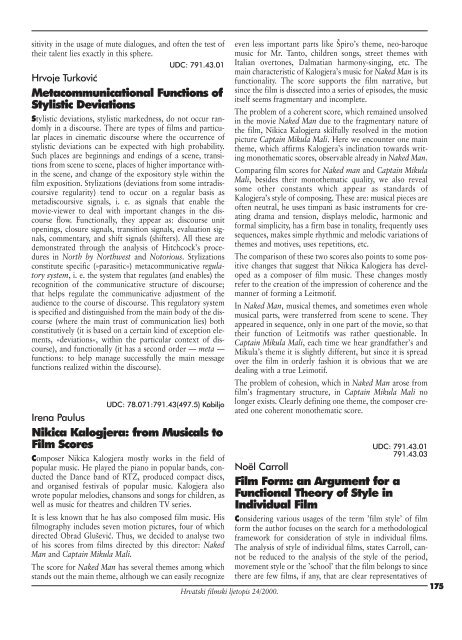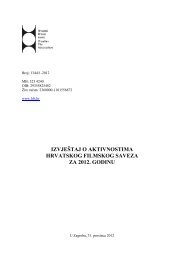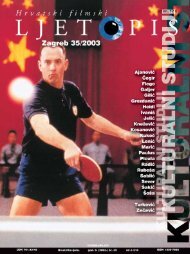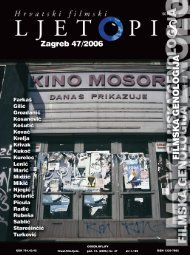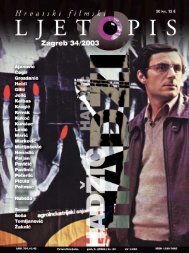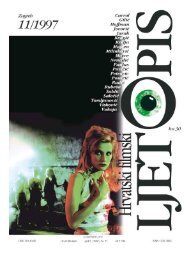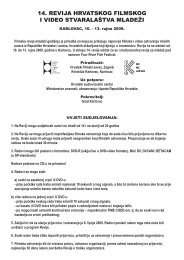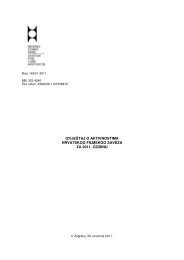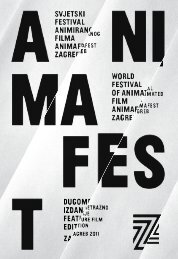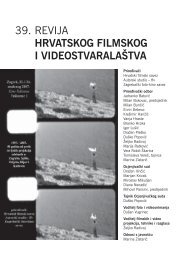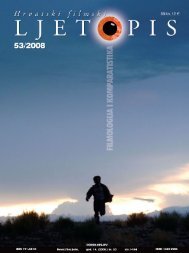You also want an ePaper? Increase the reach of your titles
YUMPU automatically turns print PDFs into web optimized ePapers that Google loves.
sitivity in the usage of mute dialogues, and often the test of<br />
their talent lies exactly in this sphere.<br />
UDC: 791.43.01<br />
Hrvoje Turkovi}<br />
Metacommunicational Functions of<br />
Stylistic Deviations<br />
Stylistic deviations, stylistic markedness, do not occur randomly<br />
in a discourse. There are types of films and particular<br />
places in cinematic discourse where the occurrence of<br />
stylistic deviations can be expected with high probability.<br />
Such places are beginnings and endings of a scene, transitions<br />
from scene to scene, places of higher importance within<br />
the scene, and change of the expository style within the<br />
film exposition. Stylizations (deviations from some intradiscoursive<br />
regularity) tend to occur on a regular basis as<br />
metadiscoursive signals, i. e. as signals that enable the<br />
movie-viewer to deal with important changes in the discourse<br />
flow. Functionally, they appear as: discourse unit<br />
openings, closure signals, transition signals, evaluation signals,<br />
commentary, and shift signals (shifters). All these are<br />
demonstrated through the analysis of Hitchcock’s procedures<br />
in North by Northwest and Notorious. Stylizations<br />
constitute specific (»parasitic«) metacommunicative regulatory<br />
system, i. e. the system that regulates (and enables) the<br />
recognition of the communicative structure of discourse;<br />
that helps regulate the communicative adjustment of the<br />
audience to the course of discourse. This regulatory system<br />
is specified and distinguished from the main body of the discourse<br />
(where the main trust of communication lies) both<br />
constitutively (it is based on a certain kind of exception elements,<br />
»deviations«, within the particular context of discourse),<br />
and functionally (it has a second order — meta —<br />
functions: to help manage successfully the main message<br />
functions realized within the discourse).<br />
UDC: 78.071:791.43(497.5) Kabiljo<br />
Irena Paulus<br />
Nikica Kalogjera: from Musicals to<br />
Film Scores<br />
Composer Nikica Kalogjera mostly works in the field of<br />
popular music. He played the piano in popular bands, conducted<br />
the Dance band of RTZ, produced compact discs,<br />
and organised festivals of popular music. Kalogjera also<br />
wrote popular melodies, chansons and songs for children, as<br />
well as music for theatres and children TV series.<br />
It is less known that he has also composed film music. His<br />
filmography includes seven motion pictures, four of which<br />
directed Obrad Glu{evi}. Thus, we decided to analyse two<br />
of his scores from films directed by this director: Naked<br />
Man and Captain Mikula Mali.<br />
The score for Naked Man has several themes among which<br />
stands out the main theme, although we can easily recognize<br />
Hrvatski filmski ljetopis <strong>24</strong>/<strong>2000</strong>.<br />
even less important parts like [piro’s theme, neo-baroque<br />
music for Mr. Tanto, children songs, street themes with<br />
Italian overtones, Dalmatian harmony-singing, etc. The<br />
main characteristic of Kalogjera’s music for Naked Man is its<br />
functionality. The score supports the film narrative, but<br />
since the film is dissected into a series of episodes, the music<br />
itself seems fragmentary and incomplete.<br />
The problem of a coherent score, which remained unsolved<br />
in the movie Naked Man due to the fragmentary nature of<br />
the film, Nikica Kalogjera skilfully resolved in the motion<br />
picture Captain Mikula Mali. Here we encounter one main<br />
theme, which affirms Kalogjera’s inclination towards writing<br />
monothematic scores, observable already in Naked Man.<br />
Comparing film scores for Naked man and Captain Mikula<br />
Mali, besides their monothematic quality, we also reveal<br />
some other constants which appear as standards of<br />
Kalogjera’s style of composing. These are: musical pieces are<br />
often neutral, he uses timpani as basic instruments for creating<br />
drama and tension, displays melodic, harmonic and<br />
formal simplicity, has a firm base in tonality, frequently uses<br />
sequences, makes simple rhythmic and melodic variations of<br />
themes and motives, uses repetitions, etc.<br />
The comparison of these two scores also points to some positive<br />
changes that suggest that Nikica Kalogjera has developed<br />
as a composer of film music. These changes mostly<br />
refer to the creation of the impression of coherence and the<br />
manner of forming a Leitmotif.<br />
In Naked Man, musical themes, and sometimes even whole<br />
musical parts, were transferred from scene to scene. They<br />
appeared in sequence, only in one part of the movie, so that<br />
their function of Leitmotifs was rather questionable. In<br />
Captain Mikula Mali, each time we hear grandfather’s and<br />
Mikula’s theme it is slightly different, but since it is spread<br />
over the film in orderly fashion it is obvious that we are<br />
dealing with a true Leimotif.<br />
The problem of cohesion, which in Naked Man arose from<br />
film’s fragmentary structure, in Captain Mikula Mali no<br />
longer exists. Clearly defining one theme, the composer created<br />
one coherent monothematic score.<br />
UDC: 791.43.01<br />
791.43.03<br />
Noël Carroll<br />
Film Form: an Argument for a<br />
Functional Theory of Style in<br />
Individual Film<br />
Considering various usages of the term ’film style’ of film<br />
form the author focuses on the search for a methodological<br />
framework for consideration of style in individual films.<br />
The analysis of style of individual films, states Carroll, cannot<br />
be reduced to the analysis of the style of the period,<br />
movement style or the ’school’ that the film belongs to since<br />
there are few films, if any, that are clear representatives of<br />
175


